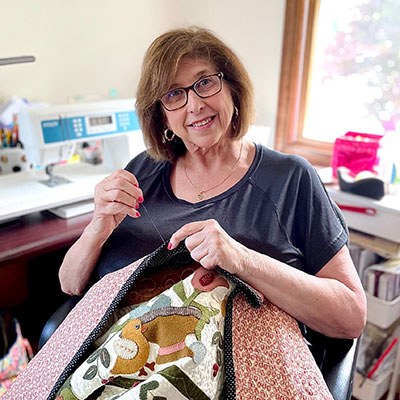Patient benefits from specialized care for pulmonary embolism

Kathy survived a serious blood clot thanks to experts with YNHH’s Pulmonary Embolism Response Team, Emergency Department and Winchester Center for Lung Disease. Today, she walks for exercise, and is an avid quilter, knitter and sewist. Throughout the COVID-19 pandemic, Kathy and friends have made more than 500 masks, including for YNHH and Smilow Cancer Hospital patients.
Kathy clearly remembers the day she couldn’t climb the stairs in her home. She thought it was an asthma attack.
It was Sunday, Dec. 13, 2020, and she was outside for about an hour talking to a friend.
“I came inside and couldn’t make it up the stairs,” said Kathy, then 63.
Kathy used her inhaler, which helped some. The next day she called the Yale New Haven Hospital Winchester Center for Lung Disease, where she is a patient. Pulmonologist Jennifer Possick, MD, prescribed prednisone and an antibiotic, and over the next few days Kathy felt a bit better. Shelley Harrigan, RN, of the Winchester Center, suggested Kathy buy a pulse oximeter to closely monitor her oxygen saturation at home. Harrigan told her to call 911 if her oxygen levels dropped markedly. Kathy had a COVID test and chest X-ray to check for pneumonia; both were negative.
Kathy felt OK Friday morning during a telehealth visit with Dr. Possick and her team, but later that afternoon, “I crashed. I got to the point where I couldn’t walk, I couldn’t breathe,” she recalled.
When her oxygen saturation dropped into a dangerous range, Kathy was rushed to YNHH’s Emergency Department. She had low blood pressure and evidence of circulatory shock, requiring special medication to support her blood pressure.
A CT pulmonary angiogram scan revealed an extensive pulmonary embolism (PE), a type of blood clot. Scan findings prompted an alert to the hospital’s Pulmonary Embolism Response Team (PERT). In 2020, YNHH became the first healthcare institution in the world to use Aidoc artificial intelligence (AI) technology for PE detection that immediately notifies the Pulmonary Embolism Response Team of a positive scan.
YNHH averages more than 250 activations per year of the PERT, which includes pulmonologists, intensivists, interventional radiologists, cardiologists and sonographers, surgeons, hematologists, emergency medicine physicians, nurses and pharmacists.
A PE, which affects about one in 1,000 people, can block blood flow to the lungs and strain the heart. Symptoms include chest pain, difficulty breathing, lightheadedness or fainting, cough, palpitations and low blood pressure. A massive or untreated PE may be associated with death.
The night of Kathy’s CT scan, PERT members performed an emergency, minimally invasive embolectomy to remove the emboli in the lungs and reduce strain on her heart.
“We saw a significant improvement in her vital signs as the clot was being removed, and she was able to be weaned off oxygen and blood pressure medications quickly,” said Akhil Khosla, MD, PERT director, Yale New Haven Health, and assistant professor of Medicine, Pulmonary, Critical Care and Sleep Medicine, Yale School of Medicine.
Kathy said she felt “totally normal” when she arrived in the ICU early the next morning.
“The quick diagnosis and treatment by the ED team, coupled with our AI program, allowed for rapid deployment of our PERT,” said Dr. Khosla.
But Kathy soon received news of two other health findings. Since she had not smoked in many years, she did not meet criteria for lung cancer screening. But the scan for the PE also showed a small lung nodule, found to be early-stage lung cancer. In April, thoracic surgeon Justin Blasberg, MD, removed part of her lung’s left upper lobe. In addition, a blood test ordered during a PERT follow-up revealed antiphospholipid syndrome, an autoimmune disorder which can trigger blood clots and is associated with pulmonary embolism.
“If it wasn’t for the pulmonary embolism, I would be living with lung cancer and the blood disorder and not knowing it,” said Kathy. The embolism “saved my life in the long run.”
In a letter praising the care team, Kathy said, “They were AMAZING – kept me calm as they could and made all the right calls … They all worked as a well-oiled machine doing their very best in a stressful situation to get me the best care possible.”
Kathy said she is also grateful for her ongoing care coordination from Dr. Possick and her team, including Shelley Harrigan, who suggested the pulse oximeter. In spring 2021, Harrigan received the hospital’s Patient Experience Award for Caring and Excellence (PEACE), in recognition of her care of Kathy.
“The good that we did came back twofold,” said Kathy. “I’m thankful for everything I can do.”
